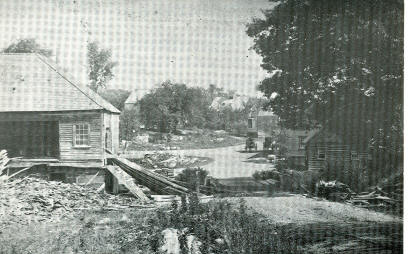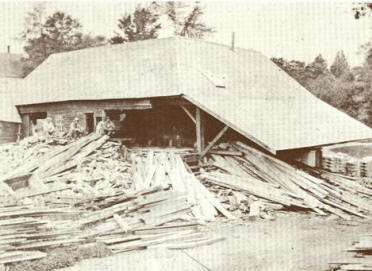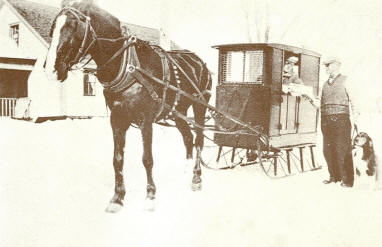|
The Mills And Other Industry
|
|
| The Mills At
Pottertown On The Plains William Potter who came to Litchfield from Topsham in 1782 and settled in the locality known for years as Pottertown, built the first sawmill in town above the bridge on the stream there in 1789. A few years later he built a grist mill, also on Potter's Mill Stream. His sons Amos and Jeremiah continued the mills until about 1870. Jeremiah Potter, one of the most enterprising men in town built about half of the houses in Pottertown and accumulated "quite a fortune for the times." But the busy brook and its water power by no means became a Potter monopoly, nor was the stream limited to saw and grist mills. The old Libby grist mill was operated by James Libby and various successors until about 1880. Both this and the Potter grist mill had separate runs of stones and bolts to make wheat flour for those who raised that grain for bread-making. About 1827 William Small built a fulling mill below the bridge. After John Neal's carding mill was carried away by the great freshet of 1825 Potter and Ashford built another such mill on Spring Brook, a branch of the mill stream. Small bought this mill to operate in conjunction with his fulling mill for the coloring and dressing of cloth. source: Litchfield Yesterdays
|
|
| Old Dam Upstream
From Plains Road Bridge In 1850 W. G. Williams built a new mill on Spring Brook and put in carding and fulling machinery. The carding works were continued until 1886. Rev. Ezra H. Daws built a dam and shop in the 1830's where the original carding machine had stood just upstream from the bridge. Here he made shingles, operated a trip-hammer and did blacksmithing. Daws sold to Abial Daily, who converted the mill to make pill boxes and brimstone ("stink") matches. The mill served various owners and purposes until 1866. In 1892 Lorin Ayer acquired all rights to a mill built about 1810 by the Potters. The mill, which stood in back of the Deacon Chase residence, was leased and operated by George M. Rogers. Coming down to the present century, Roland Godfrey remembers when the stream still powered a saw mill and a shingle mill. After a freshet took out the dam, wheel and penstock of the shingle mill David Bowie bought the mill site and hired Roland to help him rebuild the dam, and later to saw timber Bowie had bought, including some behind the Deacon Gardner Roberts place. Delmar Small was Bowie's partner during that logging venture. Edward Stevens remembers that the grist mill, which stood until 1888, was in back of the present Carl Slattery place. source: Litchfield Yesterdays
|
|
|
|

|
 |
 |
| The Purgatory
Mills Two things a new town sorely needed: sawmills to cut boards and timber, and grist mills to grind meal and flour. With two streams to furnish water power, one of them backed up by the reservoir of the four Purgatory Ponds (Tacoma Lakes), there was a wealth of good mill sites in Litchfield. At Purgatory General Dearborn, a proprietor of the town, gave water rights to the first settlers. The original dam was built at the site of the present dam, probably by Simeon Goodwin before 1800, and both saw and grist mills were erected. The mills descended to Simeon's son Andrew, whose partners were David Bartlett and Deacon Dennis, and to his grandson, Andrew J., and as a result the village was called Goodwin's Mills for three quarters of a century. The mills then passed through various hands, but remained in operation winter and spring most years. Millstones for the first grist mill came from East Monmouth (then called Juggernaut) on a raft through Winthrop Pond and Long Cove, and were then hauled through the woods, according to one account. Another run of stones was cut from a granite boulder near the Colby bridge by Simeon Goodwin in the 1790's. William Gay of Gardiner, whose father owned an interest in the old grist mill, remembered that in 1805 he often rode over from Gardiner on horseback, following a blazed trail, to get a two-bushel bag of toll grain. In 1868 the state survey of water power reported that the upper power (where the dam is now) had 12 feet head and six feet fall. The sawmill was cutting 200,000 feet of long lumber and the shingle machine about 200,000 shingles a year, while the grist mill had a "large custom". The last grist was ground about 1912. The last and one of the oldest of the mills was the saw and shingle mill called Bartlett's Mill for many years. At About the time of the above picture the operator was Charles A. Mason. The sawmill remained in operation until August 26, 1951, when it burned. It was the last of Litchfield's industries. The house that Simeon Goodwin built when he brought his family to Purgatory in 1793 still stands across the road from the mill site. It is the same house in which Simeon's son and grandson brought up their families. When Roland Godfrey lived at the Mills he worked for the sawmill people. It was his job to go to the upper dam - at the outlet of Woodbury Pond - at about 5 a.m. and open the gates. By 6:30 there was enough water for power. Roland filed saws and got things in order for the day's work by the time the rest of the crew came in at 7 a.m. source: Litchfield Yesterdays
|
|
| Elias Plimpton
came to Litchfield in 1820 from Walpole, Massachusetts, and built a
shop on the lower water power at Purgatory Falls with a trip hammer
for making hoes and axes. In 1845 he began making forks and
later, potato diggers and similar tools as listed on the trade card. Plimpton's sons, A. Warren and George, carried on the factories for many years, the second factory being added to make handles for the hoes and other tools. The business gave work to as many as 25 men. In Civil War times the firm bought the upper dam, which was rebuilt and raised adding greatly to the water storage at the mill pond and all Purgatory Ponds (Tacoma Lakes) above. Marshall Rogers remembers his father telling him that the Plimpton forks were of such fine quality that they could pass the circle test. One tine was put into a small hole in the floor and a circle scribed with the other tine or tines, which were then sprung together until they touched at the points. To pass the test a fork had to scribe a second circle exactly matching the first. source: Litchfield Yesterdays
|
 E. Plimpton And Sons' Fork And Hoe Factories At Purgatory
|
 The Mineral Springs On The Old Berry Farm
|
South of Howard Johnson's at
the rear of the farm on the Pond Road owned for generations by
Captain Nathaniel Betty and his descendants, three springs bubble
out of the rocky, sandy soil. The "mineralized water... sweet
and pure" was known by the late 1700's when a typhoid epidemic
brought settlers from Richmond and Pittston as well as Litchfield to
get the clear water. The purity of the water and its recognition for curative powers brought the springs a wide reputation. By 1900 the Forest Springs Water Company owned by Walter Morse, (Fancy Groceries, 231 Water Street, Gardiner) bought the farm and built a bottling plant at the springs. Three 34 inch oaken casks caught the water, which was brought into the plant through long logs bored down the center. After bottling it in five-gallon glass carboys and two quart bottles, Morse shipped the water "all over the East" in competition with Poland Spring water. He also peddled it in Gardiner; that business thrived until the advent in 1915 of the city's filter plant. Morse sold the farm to Frank Forrester, who in turn sold it to O. Kenneth Berry, who sold the farm about 1968. source: Litchfield Yesterdays
|
| Other Mills And
Shops Around 1878 Frank C. Wyman put steam power in his cider mill on the Upper Pond Road, where for each of the next 14 years he ground between 7000 and 8000 bushels of apples, making a total of over 10,000 barrels of cider. He had two large tanks for vinegar, holding together 15,000 gallons. Wyman also had a factory where he canned under his own label apples, applesauce and corn. He bought barrel shook by the carload, assembled the barrels and shipped apples to England and Germany. The Patten family operated for some years a furniture factory on Patten Mill Stream (Magotty Meadow Brook) near the dead River Road. source: Litchfield Yesterdays
|
|
| Post Offices And Rural Free
Delivery Mail carrier Leland Gilman, shown here in his pung one winter in the early 1920's, delivered the mail on R.F.D. No. 17 out of the Litchfield (Purgatory) Post Office for 36 years, retiring in 1957. Besides post offices at Litchfield, South Litchfield, the Plains and the Corner the town was served for years by seven rural routes: Gardiner #14, Litchfield #16, #17 and #18; Monmouth #19 and Sabattus #1 and #3. Postmasters in 1900 were Mrs. Eli Merriman at Litchfield, C.A. Metcalf at South Litchfield, A.R. Bucklin at the Plains and James E. Chase at the Corner. By 1905 the South and Plains offices were closed, and by 1920 Litchfield was the only office left. Other postmasters there were Frank Adams, Elenora Adams and Mrs. Clara Lewis. The office was moved into a new building at Bachelder's Corner (formerly South Litchfield) in 1968. source: Litchfield Yesterdays
|
 Rural Free Delivery |
